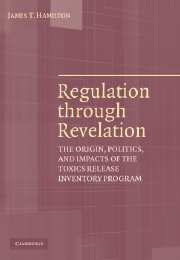 Regulation through Revelation
Regulation through Revelation Book contents
- Frontmatter
- Contents
- Acknowledgments
- Introduction
- 1 Legislating an Incomplete Contract
- 2 Defining Terms: Rulemaking and the Initial TRI Data Release
- 3 Spreading the Word in the Public and Private Sectors
- 4 Politics of Expansion and Contraction
- 5 Life Cycles in the Regulatory Environment
- 6 The Impact(s) of the TRI
- 7 Lessons from and for Regulatory Implementation
- Notes
- Bibliography
- Index
4 - Politics of Expansion and Contraction
Published online by Cambridge University Press: 24 November 2009
- Frontmatter
- Contents
- Acknowledgments
- Introduction
- 1 Legislating an Incomplete Contract
- 2 Defining Terms: Rulemaking and the Initial TRI Data Release
- 3 Spreading the Word in the Public and Private Sectors
- 4 Politics of Expansion and Contraction
- 5 Life Cycles in the Regulatory Environment
- 6 The Impact(s) of the TRI
- 7 Lessons from and for Regulatory Implementation
- Notes
- Bibliography
- Index
Summary
In the textbook story of rulemaking, Congress delegates decisions to an agency explicitly through directions in legislative text and implicitly through omissions of details in the language of a bill. Administrative procedures, the rules that govern rulemaking, affect how an agency will use the notice-and-comment process to resolve questions left open by Congress. When the dust settles, the agency publishes the final rule in the Federal Register, and the language devised becomes part of the Code of Federal Regulations. The requirements in the CFR become the rules of the road for the agency to enforce as law.
The lives of environmental regulators would be much simpler if rulemaking followed the textbook. The real dilemmas involved in agency decisionmaking, however, often lie in the rest of the story. The complexity of a regulator's task starts first with the delegation of decisionmaking from Congress. As political scientist Ken Shepsle has pointed out, Congress is a “they,” not an “it.” Regulators at EPA in search of direction from “Congress” might get conflicting advice from Democrats and Republicans, from party leaders in the House or Senate, and from members of contending oversight committees. Which “Congress” should the regulators pay heed to, the one that drafted the authorizing legislation or the one that today apportions the agency's budget and holds oversight hearings? Add into this calculation the fact that EPA has multiple principals. The President appoints the head of the agency to carry out administration policy.
- Type
- Chapter
- Information
- Regulation through RevelationThe Origin, Politics, and Impacts of the Toxics Release Inventory Program, pp. 116 - 176Publisher: Cambridge University PressPrint publication year: 2005


